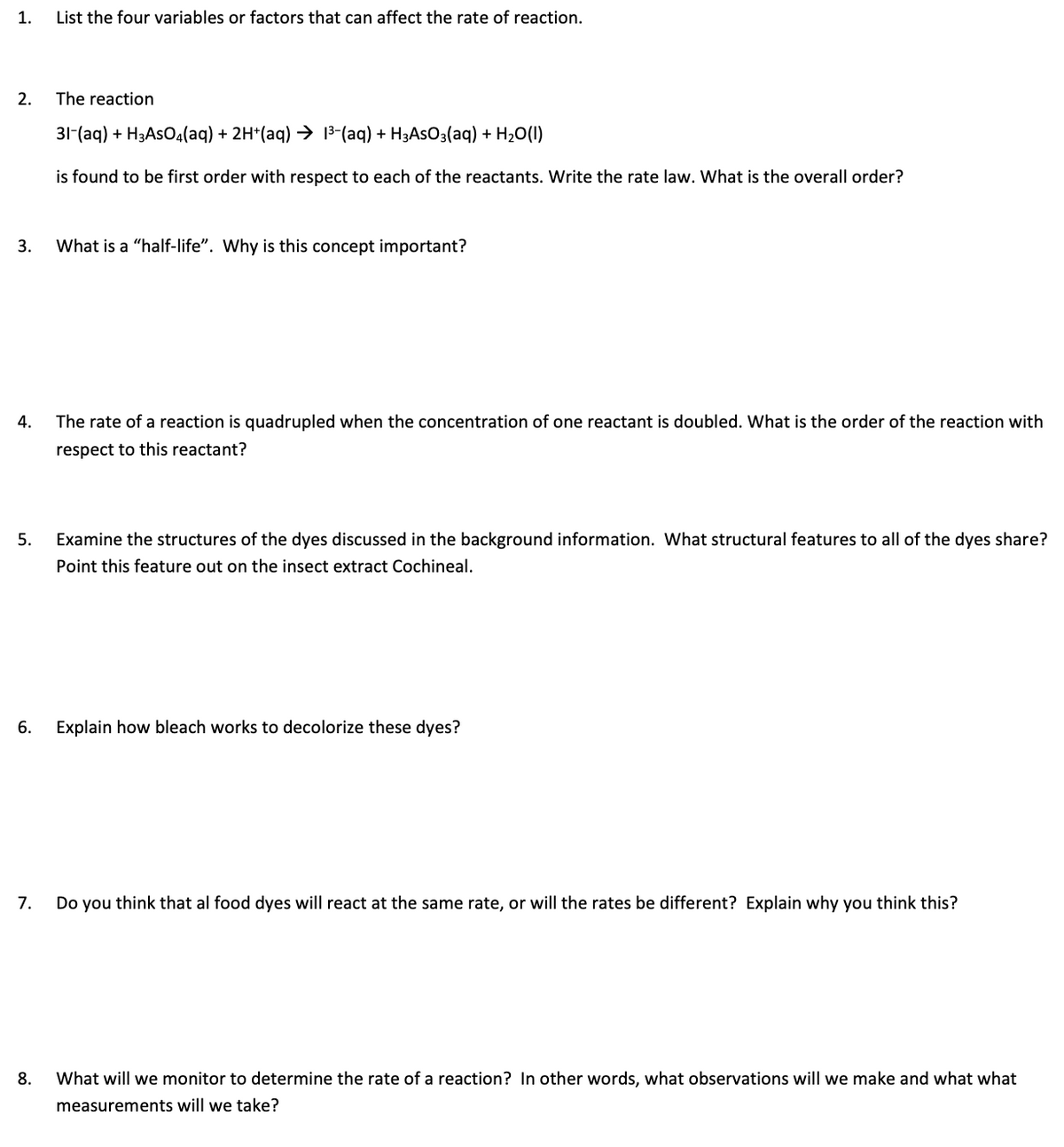Chemistry: An Atoms First Approach
2nd Edition
ISBN:9781305079243
Author:Steven S. Zumdahl, Susan A. Zumdahl
Publisher:Steven S. Zumdahl, Susan A. Zumdahl
Chapter11: Chemical Kinetics
Section: Chapter Questions
Problem 5RQ
Related questions
Question

Transcribed Image Text:1.
List the four variables or factors that can affect the rate of reaction.
2.
The reaction
31-(aq) + H3ASO4(aq) + 2H*(aq) → 13-(aq) + H3AS03(aq) + H20(1)
is found to be first order with respect to each of the reactants. Write the rate law. What is the overall order?
3.
What is a "half-life". Why is this concept important?
4.
The rate of a reaction is quadrupled when the concentration of one reactant is doubled. What is the order of the reaction with
respect to this reactant?
5.
Examine the structures of the dyes discussed in the background information. What structural features to all of the dyes share?
Point this feature out on the insect extract Cochineal.
6.
Explain how bleach works to decolorize these dyes?
7.
Do you think that al food dyes will react at the same rate, or will the rates be different? Explain why you think this?
8.
What will we monitor to determine the rate of a reaction? In other words, what observations will we make and what what
measurements will we take?
Expert Solution
This question has been solved!
Explore an expertly crafted, step-by-step solution for a thorough understanding of key concepts.
This is a popular solution!
Trending now
This is a popular solution!
Step by step
Solved in 2 steps with 1 images

Knowledge Booster
Learn more about
Need a deep-dive on the concept behind this application? Look no further. Learn more about this topic, chemistry and related others by exploring similar questions and additional content below.Recommended textbooks for you

Chemistry: An Atoms First Approach
Chemistry
ISBN:
9781305079243
Author:
Steven S. Zumdahl, Susan A. Zumdahl
Publisher:
Cengage Learning


Chemistry
Chemistry
ISBN:
9781305957404
Author:
Steven S. Zumdahl, Susan A. Zumdahl, Donald J. DeCoste
Publisher:
Cengage Learning

Chemistry: An Atoms First Approach
Chemistry
ISBN:
9781305079243
Author:
Steven S. Zumdahl, Susan A. Zumdahl
Publisher:
Cengage Learning


Chemistry
Chemistry
ISBN:
9781305957404
Author:
Steven S. Zumdahl, Susan A. Zumdahl, Donald J. DeCoste
Publisher:
Cengage Learning

Chemistry: The Molecular Science
Chemistry
ISBN:
9781285199047
Author:
John W. Moore, Conrad L. Stanitski
Publisher:
Cengage Learning

Chemistry for Engineering Students
Chemistry
ISBN:
9781337398909
Author:
Lawrence S. Brown, Tom Holme
Publisher:
Cengage Learning

Chemistry by OpenStax (2015-05-04)
Chemistry
ISBN:
9781938168390
Author:
Klaus Theopold, Richard H Langley, Paul Flowers, William R. Robinson, Mark Blaser
Publisher:
OpenStax